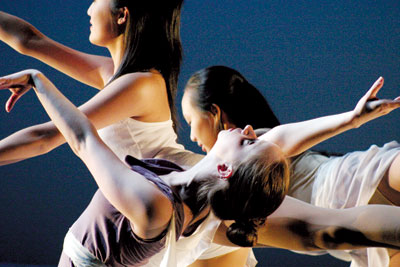All Nonfiction
- Bullying
- Books
- Academic
- Author Interviews
- Celebrity interviews
- College Articles
- College Essays
- Educator of the Year
- Heroes
- Interviews
- Memoir
- Personal Experience
- Sports
- Travel & Culture
All Opinions
- Bullying
- Current Events / Politics
- Discrimination
- Drugs / Alcohol / Smoking
- Entertainment / Celebrities
- Environment
- Love / Relationships
- Movies / Music / TV
- Pop Culture / Trends
- School / College
- Social Issues / Civics
- Spirituality / Religion
- Sports / Hobbies
All Hot Topics
- Bullying
- Community Service
- Environment
- Health
- Letters to the Editor
- Pride & Prejudice
- What Matters
- Back
Summer Guide
- Program Links
- Program Reviews
- Back
College Guide
- College Links
- College Reviews
- College Essays
- College Articles
- Back
The Reality of Dance
The audience watches in awe as the elegant dancer prances across the stage in her wooden pointe shoes; little do they know of the blisters and bruises she tries her best to hide. The nonstop stretch and strengthening classes dancers participate in everyday should be taken into consideration by the observers. Dictionary.com states that a sport is, “an athletic activity requiring skill or physical prowess and often of a competitive nature” (Sport). Too often, many perceive dance as a “dolly dinkle” art and overlook the intensity. Competitive dance should be recognized by the public as a sport.
The endlessly grueling training a dancer fights through is a sport as well as an art form. Most dancers begin the week with muscular strength focused technique classes. The teacher begins the class with a series of strengthening exercise: pike ups, V- ups, plank holds, situps, burpees, and other exercises commonly done at sports practices to improve the core and biceps. Next they slip on pointe shoes made of only wood and canvas balancing on relevé, or as the common audience member says “standing on their tippy toes.” Dancers begin by rolling up through the foot stressing tendons and rendering joints until the tip of the big toe rests solidly against the withered wood. Artistic Director of Birmingham Royal Ballet, Sir Peter Wright, firmly believes that “in dance, fitness incorporates elements of body composition, joint mobility, and respiratory fitness” required to succeed as a dancer (Koutedakis). Along with the grueling training, dancers are expected to be brisk and beautiful on stage. The expectation of dancers to obtain graceful stage presence and poise is not as easy as it may seem. Ballerinas and male ballet dancers put a tremendous amount of sweat into a single performance.These artists are expected to pointe their feet, lengthen through their limbs, head up, eyes locked on the judges, hitting every count, never bobbling on that turn. Not to mention dancers always need to be pulled up through their back, pushing their shoulders down, walking toe ball heel, all while breathing. If the dancer forgets even one aspect of “the mental checklist” everything will come crashing down. Silas Farley, charmed by New York City’s Ballet, says that dancers are expected to have “a naturally regal presence” used to the dancers advantage (25). In any professional sport, such as baseball, “Batting can be dangerous if players arbitrarily start swinging a bat,” they too have a checklist to mentally go over before they take their first swing. As well as any other sport, the amount of practice dancers participate in can become extreme. Dance teachers are not aware of the stress placed on students because they do not attend public school; therefore, they expect their students to attend practice every day for about six hours.
According to SKYD Magazine, “Those participating on club sports teams practiced less, averaging 6.5-7 hours a week” (Pashley). The average dancer practices four to five days a week along with a minimum of ten hours in the studio-- rehearsing more than the average sport. Without a doubt, dance should be perceived as a respectable sport.
In spite of the compelling evidence demonstrating competitive dance as a sport, some argue that there are no concrete rules and regulations to the art. There are multitudes of different kinds of dance ranging from ballet to hip hop and competitive to recreational. Again referring baseball, the Knickerbocker rules were set by a New York man by the name of Alexander J. Cartwright, who is considered “The father of baseball.” The sport ordained the rules in 1953 as they are still set today. When moving from the East Coast to the West, the idea of dance evolves because dance does not have set rules. Some dances such as hip hop are widely known on the West Coast for their grunginess while the Easterners keep close to the original hip hop style. Groove National Dance Competition states that dancers are willing “to comply with rules and regulations set forth” with intentions of improving the sport (Groove). There is currently not a book of rules and regulations guiding what styles of dance are and are not a sport, but competitive teams would be more than willing to accept them.
Everyone wants recognized for their hard work, right? Famous ballet dancer Baryshnikov once said, “Dancers are to be correctly seen as athletes as much as artists” (Dance). Dancers work hard to be muscularly toned; dancers present elegant poise and stage presence, and dancers practice more often than the average sport. Dancers have equally as much athleticism as common sports players.

Similar Articles
JOIN THE DISCUSSION
This article has 0 comments.
